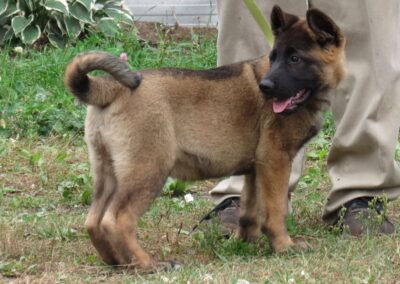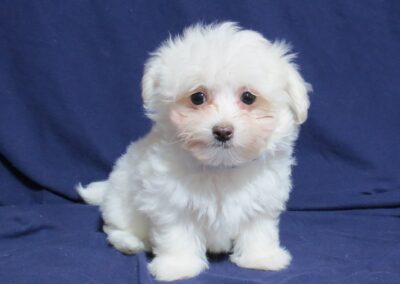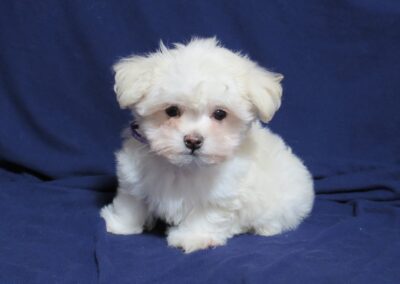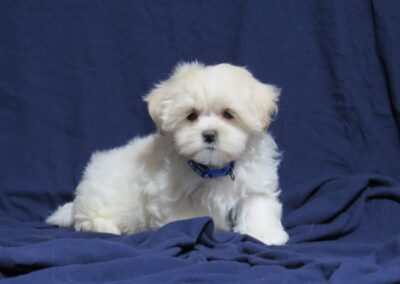Bringing Your New Puppy Home
Bringing a new member into your family can create many different emotions. Lots of excitement with a touch of uneasiness how your puppy will adjust. We believe the key ingredients to having a healthy, happy, well-adjusted puppy is found in proper nutrition, socialization, and early consistent training!
Below you will find puppy advice that will help you with this process!
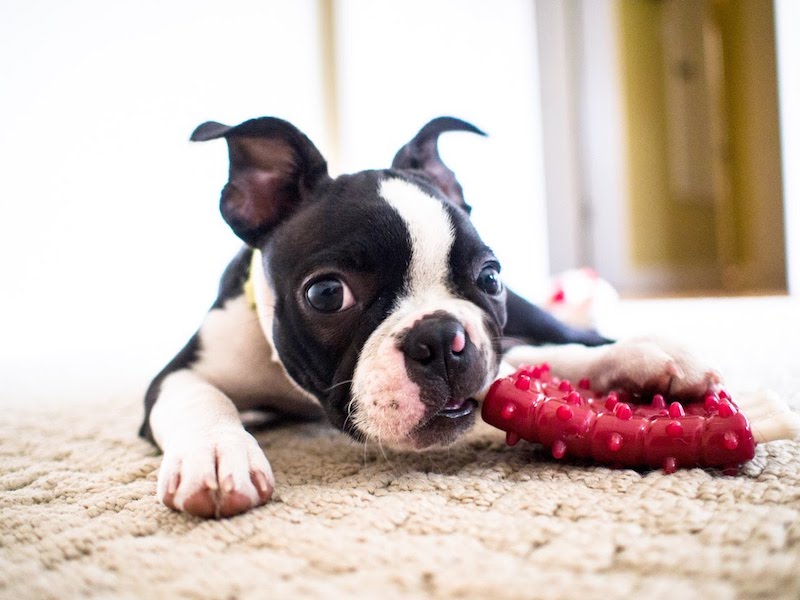
House Training
A young puppy needs special care, much as a new baby would. Treat the puppy as you would your own infant with loving patience, constant supervision, and a gentle touch. Like kids, your puppy can easily become spoiled without proper training and discipline. Being consistent and patient with your expectations is very important, only spoiling with lots of kisses, hugs, and loving attention!
Moving to a new home is a big change for a puppy. Expect the puppy to take a few days to acclimate to its new surroundings. How you and your family interact with your puppy at this age is crucial to it’s socialization. Acclimate your puppy slowly to your normal daily routine with positive encounters.
We recommend housebreaking your puppy by using a crate. Some people may cringe at the thought of using one, but dogs are actually den animals. After the adjustment (sometimes tough) of leaving their litter mates, they will find much comfort and security in their cave crate environment. This makes it easy to train your dog to love her crate! This method will also help pups with anxiety and to feel comfortable being alone at times when necessary.
The principal in using a crate is that dogs like their “den” clean and avoid going to the bathroom near their eating and sleeping areas. Their instinct will be to keep their crate clean! We also have found it helpful to attach a small playpen area to crate which allows the puppy to have a little more freedom during a portion of daytime crate time, all the while having the crate door open for them to retreat to at anytime.
Early Crate Training Here:
Our adult dogs have a doggie door here to go outside whenever they please! Each one is trained to potty outside. At 5-6 weeks your puppy will learn to use this door, as their Mother teaches them to go potty outside only, creating a clean “den” area for them inside! They learn from the best. 🙂 They will be trained not to go potty in their “den” area here. When home, your puppy will have to learn to adapt to their new crate “den” area in their new home (which should not take long) and then to go potty outside or use the puppy pad. They will be off to a great start. The majority of our puppies will never have an accident in their crate!
Following a Potty Schedule is a key success factor in training!
Potty Schedule:
- First thing in the morning
- After eating
- After drinking
- After napping
- Before bed
- Once in the middle of the night
Take the puppy outside every 2 1⁄2 hours and 1⁄2 hour after eating (once during the night). Take him out the same door and to the same spot every time. This will create a “Potty for Life” spot. Once again be patient and be consistent!
NOTE: Be a helicopter parent! 🙂 All play time should be supervised. Keep your puppy in exercise pen whenever you are not directly supervising them. Do not allow free access to the house yet, as that will only result in making house training mistakes. If they pee or poop in the wrong areas, they will return to those areas more and more. Clean these areas well to remove any scent!
• Be alert for signs (sniffing, whining, scratching, and circling) that he has to go potty, say “potty” and take him quickly outside or to puppy pad. If he goes, praise him and give him a small treat when he does “his business” there. Never punish an accident. He won’t understand and may learn to go when you are out of sight
• Take him out the same door and to the same spot every time. This will create a “Potty for Life” spot.
“Potty for Life”: If you are wanting your pup to potty in the same area of your yard every time, follow our “Potty for Life” tip:
• We recommend setting up a small pen in your grass or outside potty area for him to hang out at potty time. (check our our Puppy Shopping list for pen) This should help him get used to going potty outside while assisting with the distractions in the yard and their favorite people! 🙂 This will also encourage him to head to the same spot when he has to go. We discourage playing with him at this time. Keep letting him know to do his business.
Puppy Pad Training: Keep the puppy pad in exercise pen area. Puppy will pick up on idea of only going potty on the pad. Cover the exercise area floor with Puppy Pads (you may have to tape down.) In two days, take a pad away. Two days later, remove another, and so on. The idea is to wean puppy off of each pad until there is only one left. If she pees outside of the remaining pads, put the one back and start over. After she has got that down, take her to her pad regularly and wait for her to go. I would keep her on leash to prevent her from wandering away: simply stand with her at her spot, on-leash, and ignore her until she goes.
Do NOT Puppy Pad Train and Out Door Train your Puppy at the same time. This will be confusing to the puppy. If you wish them to be trained both ways. Introduce one method, once they have that down, introduce another!
As your puppy begins to recognize the schedule, it becomes easier. Potty training can be done in 3-4 weeks depending how the puppy responds to its training.
Your Puppy's Diet
Do not put the food in a bowl and assume your puppy is eating. Pay careful attention to how much he is actually eating each day because this is critical to their health. If you are concerned with minimal eating habits use Enercal (as seen on our Puppy Shopping list) and/or blend a small portion of warm water with his normal ration, creating thick smoothie consistency for enticement!
The small breed puppies do not have a large fat reserve, so it is essential that these puppies eat three meals a day. Missing a single meal can cause these puppies to have dangerously low glucose levels (hypoglycemia). Once a puppy’s glucose levels are low, he might become too confused to eat and could refuse food.
Your new puppy should be eating three times a day (see Potty Schedule). 1/2 cup of dry food total (approximate). We feed our puppies Inukshuk Professional 26/16 Dog Food. Your puppy will be sent home with a small bag of our Puppy Food along with a feeding guide and instructions on how to gradually switch puppy over to an alternative if you prefer!
Whichever food you choose to feed your puppy, always read the label!
Once your puppy reaches around six months old, switch to two feedings a day and maintain this through through maturity. Your puppy can be switched to an adult formula food between 9-12 mo. of age. If you choose to switch to a different brand of dog food, the change must be a gradual one. Change the food over a 4 day time period, giving 100% of the original food the first day, 75% original food and 25% new food the second day, 50% of each the third day, and 25% of the original and 75% new the fourth day. This gradual change will reduce the amount of stress to the puppy.
As your puppy grows follow the directions on the bag for the age and weight of your puppy.
Nap Time
A new puppy will need to have nap times throughout the day to rest. It is also important that he has a warm place to sleep. Be aware that play times are kept short, whether the play is with people or other pets. Puppies can play themselves into exhaustion or not take the time to eat or drink. Your puppy should also be able to retreat to it’s “den” or crate on its own accord if it becomes tired or frightened.
Socializing with other pets
All contact between a new puppy and resident pet should be 100% supervised for the first two weeks minimum. Be especially careful if your other pets are much larger than your new puppy. We suggest separating your pets with child safety gates or pet exercise pens until they are acclimated.
Until your puppy has completed its immunization shots, remember to keep your puppy away from areas where non-resident pets may frequent. (public parks, rest stops)
When your puppy comes home, it is NOT fully immune to the many viruses until all booster shots have been given. We encourage you to speak with your licensed Veterinarian about completing these vaccinations when you receive your puppy. Your puppy will be up to date with our de-worming and vaccination program when he/she goes home!
Dental Care
You should begin a good schedule of teeth cleaning as soon as you bring your puppy home! When you and your puppy are calm, use a toothbrush or finger brush (no toothpaste) and gently rub teeth. Making sure to get top, bottom, front, and back teeth. This can be done a few times per week. After 2 weeks, begin using a small amount of tooth paste. Always praise your puppy during this process. Once, everyone is comfortable, you can change your schedule to brushing once a week. Bones and hard rubber toys can also help maintain oral health. See our shopping guide for oral health toy suggestions. HINT: You can start with beef/chicken broth on your finger or brush to get him/her used to, and loving, the brushing process.
Eye Care
Sometimes eye staining in small breeds can be present. You can limit staining and maintain healthy eyes to prevent infections and severe staining.
Things to do at home to promote healthy eyes.
- Wipe around the eyes with warm wet cloth 1-2x per day.
- Keep hair around the eyes trimmed well.
- Use a very fine bristle or comb to get the small hair and eye crust away from eyes.
- 1 TBSP a day of original Greek yogurt.
If staining persists, please see our puppy shopping list “Angel Eye Chews”
Puppy's First Words
When you take your puppy outside or to the bell to go out, ring the bell with the pup’s paw and say, “Outside”.
“Potty”
When you get to the spot in the yard where you would like your puppy to eliminate, say “Potty” as you let the pup sniff around. If you would like pup to do a second after the first one, say “Potty again” and be patient!
Leave It
This is going to be your pup’s middle name soon. When you want pup to ignore something rather than give attention to it, tell pup to “leave it!” Even if pup is barking at someone across the street, say “leave it” and try to redirect the pup’s attention to something better like a toy or you.
Yes
We use “yes” just like you would use a clicker in clicker training. When you want you pup to do or not do to something, and pup complies, then immediately say “yes”. It is much nicer than “no” and pup needs to hear it sometimes too.
Let go
If your puppy gets ahold of something and won’t let go, say “Let go” and open pup’s mouth and take the unauthorized item. If pup lets go nicely, make sure you reward for a good deed. If the pup fights you for it, nicely just open jaw by squeezing the hinged back area open, take the item out, and say “yes” as if it was the pup’s idea all along. Try to make positive out of every situation that you can.
Settle
When pup is acting too rambunctious for a situation (like acting out at the vet) say “settle” and keep the leash very short so that pup has no other choice. Once pup has struggled enough to wear down a bit, it will naturally relax a bit at which time you may also relax the leash a bit.
This Way
When you begin walking your puppy on a leash, there may be some wandering and lolly-gagging on the part of the pup that causes some frustration. To help pup stay on track, give reminders and guidance along the way. If pup is pulling the wrong direction, say “this way” and gently guide the right way.
Go Crate
It takes a while for most pups to become attached to the crate so that they want to be in it instead of being with you. Always say “go crate” when you set pup inside. Eventually you should be able to “send” pup from anywhere to the crate if you are clear about what you want them to do. If pups resist, gently set pup in and shut door quickly.
Harzardous Items
Keep household cleaners and chemicals out of his reach. Restrict access to food, plants and chemicals that are dangerous to dogs:
- Foods: chocolate, caffeine, onions, garlic, chives, moldy foods, alcoholic beverages, nuts, grapes, raisins, yeast dough, corn on the cob, Xylitol (found in sugar free diet foods), milk, bleu cheese.
- Plants: Azalea, Amaryllis, Daffodil, Bird of Paradise, Eucalyptus, Hyacinth, Hydrangea, Iris, Calla Lilly, Morning Glory, Rhododendron, Rose, Jade, Tomato plants, Tulips, Poison Ivy/Oak
- Chemicals: Antifreeze, Ibuprofen, rat bait.
Remember to safely store all chemicals out of reach.
Make sure breakable items are out of reach. Put up electrical cords so he won’t chew on them. Keep toys off of the floor-since some parts may be small enough for your puppy to swallow. Use a cover and/or protective fencing if you have a pool or hot tub.

Healthy, Vaccinated, & Ready for Cuddles!
All puppies are Vet Checked, Vaccinated and Dewormed. All puppies are sold with a Spay and Neuter Contract.
We feed Inukshuk Professional Dog Food to all our puppies.
Available Puppies
Address
Fredericton, NB, Canada
E6L 2N9
Follow
puppies@youngskennel.ca
Phone
(506) 363-4150


